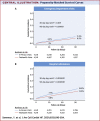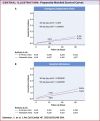Outpatient Management of Heart Failure During the COVID-19 Pandemic After Adoption of a Telehealth Model
- PMID: 34857175
- PMCID: PMC8494054
- DOI: 10.1016/j.jchf.2021.07.003
Outpatient Management of Heart Failure During the COVID-19 Pandemic After Adoption of a Telehealth Model
Abstract
Objectives: This study sought to determine whether the increased use of telehealth was associated with a difference in outcomes for outpatients with heart failure.
Background: The COVID-19 pandemic led to dramatic changes in the delivery of outpatient care. It is unclear whether increased use of telehealth affected outcomes for outpatients with heart failure.
Methods: In March 2020, a large Midwestern health care system, encompassing 16 cardiology clinics, 16 emergency departments, and 12 hospitals, initiated a telehealth-based model for outpatient care in the setting of the COVID-19 pandemic. A propensity-matched analysis was performed to compare outcomes between outpatients seen in-person in 2018 and 2019 and via telemedicine in 2020.
Results: Among 8,263 unique patients with heart failure with 15,421 clinic visits seen from March 15 to June 15, telehealth was employed in 88.5% of 2020 visits but in none in 2018 or 2019. Despite the pandemic, more outpatients were seen in 2020 (n = 5,224) versus 2018 and 2019 (n = 5,099 per year). Using propensity matching, 4,541 telehealth visits in 2020 were compared with 4,541 in-person visits in 2018 and 2019, and groups were well matched. Mortality was similar for telehealth and in-person visits at both 30 days (0.8% vs 0.7%) and 90 days (2.9% vs 2.4%). Likewise, there was no excess in hospital encounters or need for intensive care with telehealth visits.
Conclusions: A telehealth model for outpatients with heart failure allowed for distanced encounters without increases in subsequent acute care or mortality. As the pressures of the COVID-19 pandemic abate, these data suggest that telehealth outpatient visits in patients with heart failure can be safely incorporated into clinical practice.
Keywords: cardiomyopathy; electronic medical record; telehealth visits; video visits.
Copyright © 2021 American College of Cardiology Foundation. Published by Elsevier Inc. All rights reserved.
Conflict of interest statement
Funding Support and Author Disclosures Dr Spertus is the principal investigator of grants from National Institutes of Health, Abbott Vascular, and the American College of Cardiology Foundation; is a consultant to Janssen, Novartis, Amgen, Myokardia, AstraZeneca, Bayer, and Merck; serves on the Scientific Advisory Board of United Healthcare and the Board of Directors for Blue Cross Blue Shield of Kansas City; owns the copyright to the Kansas City Cardiomyopathy Questionnaire, Seattle Angina Questionnaire, and Peripheral Artery Questionnaire; and has an equity interest in Health Outcomes Sciences. Dr Sperry is a consultant to Pfizer and Alnylam. All other authors have reported that they have no relationships relevant to the contents of this paper to disclose.
Figures







Comment in
-
Look After You Leap.JACC Heart Fail. 2021 Dec;9(12):925-926. doi: 10.1016/j.jchf.2021.09.003. JACC Heart Fail. 2021. PMID: 34857176 Free PMC article.
-
Reply: Telehealth: The Future of Consultations?JACC Heart Fail. 2022 Apr;10(4):291-292. doi: 10.1016/j.jchf.2022.01.013. JACC Heart Fail. 2022. PMID: 35361451 Free PMC article. No abstract available.
-
Telehealth: The Future of Consultations?JACC Heart Fail. 2022 Apr;10(4):291. doi: 10.1016/j.jchf.2022.01.015. JACC Heart Fail. 2022. PMID: 35361452 Free PMC article. No abstract available.
References
-
- Centers for Medicare and Medicaid Services . Department of Health and Human Services; 2020. Medicare Telemedicine Health Care Provider Fact Sheet. Accessed June 10, 2021. https://www.cms.gov/newsroom/fact-sheets/medicare-telemedicine-health-ca....
MeSH terms
LinkOut - more resources
Full Text Sources
Medical
Research Materials

